First BT Trial of Future G.Fast Copper Broadband Hits Nearly 720Mbps
The next generation of hybrid-fibre G.fast (aka – FTTC2 / ITU G.9700) and FTTdp broadband technology managed to achieve an aggregate downstream / upstream speed of nearly 720Mbps (Megabits per second) during BTOpenreach’s first UK trial with Huawei, which took place at several homes near the operators Adastral Park engineering HQ in Ipswich (England).
The highly experimental trial, which was announced last year (here) and had been designed to prove the physics of G.fast transmission on an actual copper plant, was the first one to be conducted by BT outside of a lab environment and involved three short copper lines (homes).
Advertisement
Thankfully ISPreview.co.uk has been able to get our hands on an official report from BT’s on-going trial, which reveals quite a lot about its potential capabilities. But the hardware involved is still based off early prototypes, which are most certainly not standards complaint. The first proper kit from Broadcom, Huawei’s HiSilicon, Lantiq and Sckipio isn’t due to surface until the very end of 2014 or early 2015.
What is G.fast?
At present BT’s mass-market Fibre-to-the-Cabinet (FTTC) solution can deliver speeds of up to 80Mbps using 17MHz (radio frequency spectrum), which works by replacing the existing copper cable between street cabinets and your local telephone exchange with a fibre optic line. The final run (between cabinets and homes/offices) is then managed by VDSL2 technology over your existing copper line, which works like ADSL but is faster over short distances (VDSL2 works best at distances of sub-400 metres but it can operate at up to around 2000m with significantly slower speeds).
By comparison G.fast works in a similar way to VDSL2 but it’s been designed for considerably shorter runs of copper cable (ideally below 250m but there may be benefits up to around 400m) and uses 17 – 106MHz (note: the specification allows for potentially even higher frequencies in the future), which means that to work at its best it needs to be paired with a Fibre to the Distribution Point (FTTdp) / Fibre to the Remote Node (FTTRN) style solution (i.e. shortening the run of remaining copper lines by replacing more of it with fibre optic).
In simple terms FTTdp/rN takes the street cabinet out of the equation and instead brings the fibre optic cable all the way to a smaller and low powered ‘remote node’, which could be positioned underground or on a telegraph pole nearer to your home. Note: this isn’t to say that G.fast couldn’t be run from a street cabinet too, but BT also needed to test FTTdp/rN and it makes sense to combine them (note: BT is currently about to trial FTTrN in several larger areas using existing FTTC technology).
Advertisement
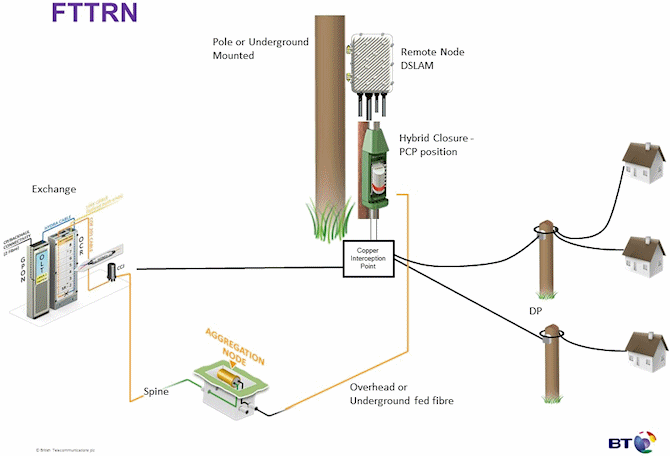
Openreach’s G.fast Trial Results
The operators G.fast trial was fed by the Portman Road telephone exchange (Ipswich) via an Integrated Layer 2 Switch with XG-PON1 link to trial DPU and GE connectivity to Adastral. The trial used existing duct structures and distribution point (DP) locations, but created a separate overlay to prevent harm to BT’s existing plant.
Dedicated copper lines, of lengths 19 metres (house 1), 47 metres (house 2) and 66 metres (house 3), were fed into the customer premises where they terminated on the G.fast NTE + end-user hardware (router etc.). Several different frequency plans were tested, both with and without vectoring enabled (this is a technology that’s designed to remove crosstalk interference from the lines).
The performance returned was extremely impressive, as can be seen below, albeit not yet representative of a larger real-world environment using final hardware.
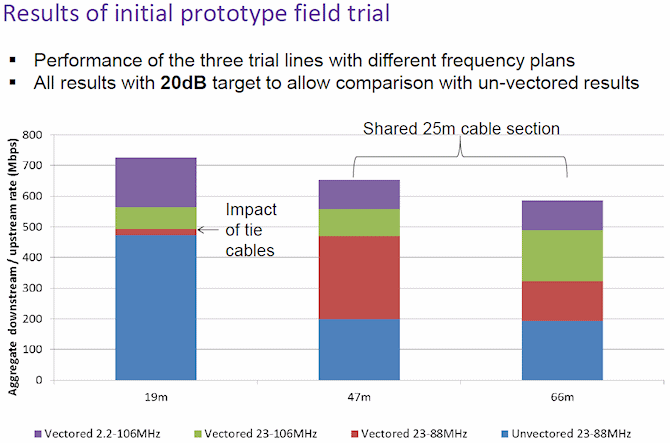
It’s worth noting that BT sees upstream speeds as a way to differentiate themselves from Virgin Media’s cable platform, which often dominate in terms of download performance but not uploads (here). G.fast appears to be a good fit for that approach because it can deliver significant benefits to both the upstream and downstream side, provided you live close enough (note: most premises reside within around 400m of their nearest street cabinet / dp).
Advertisement
The report also took a closer look at the 3rd home on the longest 66 metre line to gauge how performance changed between the different frequency plans and vectoring (note: we anticipate that g.fast will be deployed with vectoring enabled by default).
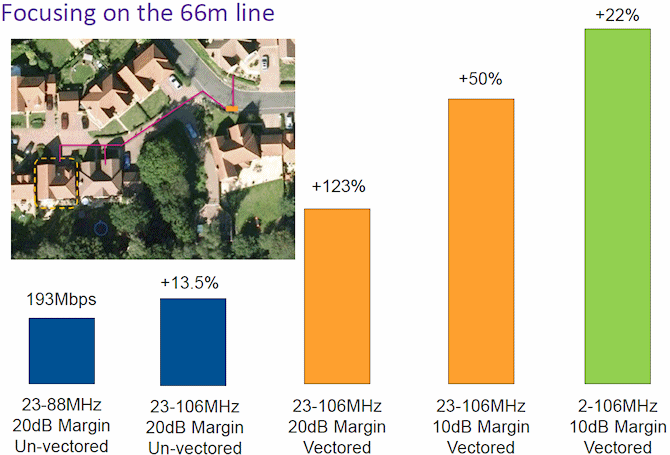
Overall BT considers that the first, if admittedly extremely small, field trial was broadly successful and has “significant potential“. Indeed some sources hint that they may even jump the plan to roll-out Vectoring on existing FTTC lines and skip right to G.fast, although we have yet to see any firm proof of this.
It should be separately noted that the Phase 2 FTTC Vectoring trials are already underway. In any case G.fast is still some years from a full commercial deployment (maybe starting in the 2016-18 window for the UK), assuming it happens at all.
Elsewhere we note that the results from BT’s test appear to be broadly in agreement with one of Alcatel-Lucent’s recent trials, which similarly demonstrated that 650Mbps was possible at around 50m with vectoring enabled (AL’s test was probably setup in a not dissimilarly way to BT).
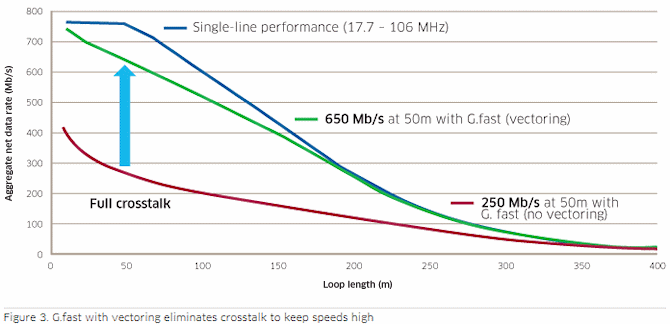
At this point it’s wise to stress that trials like this do not yet reflect a real-world environment and the report agrees, “BT continues to believe that G.Fast has significant potential, though it has yet to be proven in operational deployment in a final standards compliant form. We are currently focused on driving the ITU, BBF and ETSI standards to completion.”
A BTOpenreach Spokesman told ISPreview.co.uk:
“We are currently trialling G.Fast prototype kit in our research labs at Adastral Park. We’re watching this technology with interest given it’s capable of theoretical speeds of up to 1Gbps. We intend to trial the fully standardised kit once it’s available from the vendors.
Given it’s an emerging technology we’ve made no decision around whether or how it might be deployed in our network in the future.”
Just one of several potential problems, aside of the hefty upgrade cost (depending upon how they choose to do it), is that the performance of a G.fast line could suffer if it needs to coexist with VDSL2, which currently requires 17MHz of the spectrum. A recent example from Swisscom, which is highlighted over at Fast Net News, notes how vectored FTTC/VDSL2 can deliver a bit over 115Mbps (25Mbps upload) at up to 100 and 200 metres from the street cabinet, which rises to 700Mbps and 380Mbps (aggregate DL+UL speed) respectively for G.fast with access to the full spectrum.
But if G.fast has to coexist with VDSL2 then the speed falls to 580Mbps at 100m and 280Mbps at 200m (aggregate). Stretch to 400 metres and FTTC delivers a little less at 95Mbps (22Mbps upload), while G.fast on its own could do 140Mbps, but add in VDSL and suddenly G.fast can only deliver 40Mbps (i.e. worse than the current FTTC/VDSL setup). This largely reinforces why many studies describe G.fast as being of primary benefit to sub-250 metre copper lines. In other words, it could be very fast for some but many people wouldn’t see a huge benefit unless FTTdp is adopted more widely.
Ultimately the reality will only become clear once BT can test with standards compliant hardware and that seems unlikely to happen until sometime in H1 next year.
Mark is a professional technology writer, IT consultant and computer engineer from Dorset (England), he also founded ISPreview in 1999 and enjoys analysing the latest telecoms and broadband developments. Find me on X (Twitter), Mastodon, Facebook, BlueSky, Threads.net and Linkedin.
« B4RN Clone B4YS Hits 1Gbps Rural FTTH Broadband Funding Target
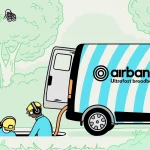









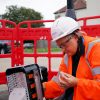







































Comments are closed